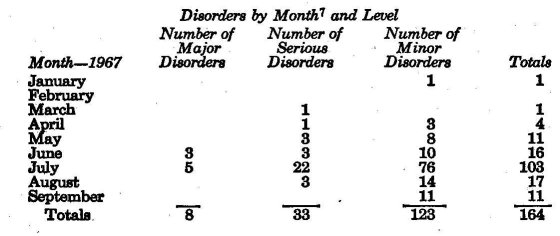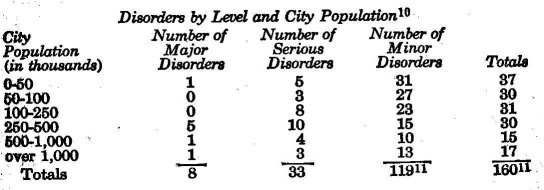Chapter 2 I THE PATTERN OF VIOLENCE AND DAMAGE
| Reports - Kerner Commission Report |
Drug Abuse
I THE PATTERN OF VIOLENCE AND DAMAGE
Levels of Violence and Damage
Because definitions of "civil disorder" vary widely, between 51 and 217 disorders were recorded by various agencies as having occurred during the first nine months of 1967. From these sources we have developed a list of 164 disorders which occurred during that period.1 We have ranked them in three categories of violence and damage utilizing such criteria as the degree and duration of violence, the number of active participants, and the level of law enforcement response:
Major Disorders—Eight disorders, 5 percent of the total, were major. These were characterized generally by a combination of the following factors: (1) many fires, intensive looting, and reports of sniping; (2) violence lasting more than two days; (3) sizeable crowds; and (4) use of National Guard or federal forces2 as well as other control forces.
Serious disorders—Thirty-three disorders, 20 percent of the total, were serious but not major. These were characterized generally by: (1) isolated looting, some fires, and some rock throwing; (2) violence lasting between one and two days; (3) only one sizeable crowd or many small groups; and (4) use of state police3 though generally not National Guard or federal forces.
Minor disorders—One hundred and twenty-three disorders, 75 percent of the total, were minor. These would not have been classified as "riots" or received wide press attention without national conditioning to a "riot climate." They were characterized generally by: (1) a few fires and broken windows; (2) violence lasting generally less than one day; (3) participation by only small numbers of people; and (4) use, in most cases, only of local police or police from a neighboring community.4
The 164 disorders which we have categorized occurred in128 cities. Twenty-five (20 percent) of the cities had two or more disturbances. New York had five separate disorders, Chicago had four, six cities had three and 17 cities had two.5 Two cities which experienced a major disorder—Cincinnati and Tampa—had subsequent disorders; Cincinnati had two more. However, in these two cities the later disorders were less serious than the earlier ones. In only two cities were later
disorders more severe.
Three conclusions emerge from the data:
• The significance of the 1967 disorders cannot be minimized. The level of disorder was major or serious, in terms of our criteria, on 41 occasions in 39 cities.
• The level of disorder, however, has been exaggerated. Three-fourths of the disorders were relatively minor and would not have been regarded as nationally-newsworthy "riots" in prior years.
• The fact that a city had experienced disorder earlier in 1967 did not immunize it from further violence.
Distribution in Terms of Time, Area and Size of Community
Time—In 1967, disorders occurred with increasing frequency as summer approached and tapered off as it waned. More than 60 percent of the 164 disorders occurred in July alone.

Space—The violence was not limited to any one section of the country.

When timing and location are considered together, other relationships appear. Ninety-eight disorders can be grouped into 23 clusters, which consist of two or more disturbances occurring within two weeks and within a few hundred miles of each other.
"Clustering" was particularly striking for two sets of cities. The first, centered on Newark, consisted of disorders in 14 New Jersey cities. The second, centered on Detroit, consisted of disturbances in seven cities in Michigan and one in Ohio.°
Size of Community—The violence was not limited to large cities. Seven of the eight major disorders occurred in communities with populations of 250,000 or more. But 37 (23 percent) of the disorders reviewed occurred in communities with populations of 50,000 or less; and 67 disorders (41 percent) occurred in communities with populations of 100,000 or less, including nine (about 22 percent) of the 41 serious or major disturbances.

Death, Injury and Damage
In its study of 75 disturbances in 67 cities, the Permanent Subcommittee on Investigations of the Senate Committee on Government Operations reported 83 deaths and 1,897 injuries.12 Deaths occurred in 12 of these disturbances. More
- than 80 percent of the deaths and more than half the injuries occurred in Newark and Detroit. In more than 60 percent of the disturbances, no deaths and no more than 10 injuries were reported.13
Substantial damage to property also tended to be concentrated in a relatively small number of cities. Of the disorders which the Commission surveyed, significant damage resulted in Detroit ($40-45 million), Newark ($10.2 million), and Cincinnati (more than $1 million). In each of nine cities, damage was estimated at less than $100,000.14
Fire caused extensive damage in Detroit and Cincinnati, two of the three cities which suffered the greatest destruction of property.15 Newark had relatively little loss from fire but extensive inventory loss from looting and damage to stock.16
Damage estimates made at the time of the Newark and Detroit disorders were later greatly reduced. Early estimates
in Newark ranged from $15 to $25 million; a month later the . estimate was revised to $10.2 million In Detroit, newspaper ,damage estimates at first ranged from $200 million to $500 million, the highest recent estimate is $45 million."
What we have said should not obscure three important factors. First, the dollar cost of the disorder should be increased by the extraordinary administrative expenses of municipal, state and Federal governments.18 Second, deaths and injuries are not the sole measures of the cost of civil disorders in human terms. For example, the cost of dislocation of people—though clearly not quantifiable in dollars and cents—was a significant factor in Detroit, the one case in which many residences were destroyed.19 Other human costs—fear, distrust, and alienation—were incurred in every disorder. Third, even a relatively low level of violence and damage in absolute terms may seriously disrupt a small or medium-sized community.
Victims of Violence
Of the 83 persons who died in the 75 disorders studied by the Permanent Subcommittee on Investigation, about 10 percent were public officials, primarily law officers and firemen. Among the injured, public officials made up 38 percent.29 The overwhelming majority of the civilians killed and injured were Negroes.
Retail businesses suffered a much larger proportion of the damage during the disorders than public institutions, industrial properties, or private residences. In Newark, 1,029 establishments, affecting some 4,492 employers and employees, suffered damage to buildings or loss of inventory or both. Those which suffered the greatest loss through looting, in descending order of loss, were liquor, clothing, and furniture stores.
White-owned businesses are widely believed to have been damaged much more frequently than those owned by Negroes. Twat least nine of the cities studied, the damage seems to have been, at least in part, the result of deliberate attacks on white-owned businesses characterized in the Negro community as unfair or disrespectful toward Negroes.21
Not all the listed damage was purposeful or was caused by rioters. Some was a by-product of violence. In certain instances police and fire department control efforts caused damage. The New Jersey commission on civil disorders has found that in Newark, retributive action was taken against Negro-owned property by control forces.22 Some damage was accidental. In Detroit some fire damage, especially to residences, may have been caused primarily by a heavy wind.
Public institutions generally were not targets of serious attacks,28 but police and fire equipment was damaged in at least 15 of the 23 cities.24
Of the cities surveyed, significant damage to residences occurred only in Detroit. In at least nine of the 22 other cities there was minor damage to residences, often resulting from fires in adjacent businesses.25
| < Prev | Next > |
|---|












